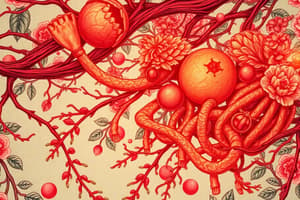Podcast
Questions and Answers
At what stage of development does blood production shift from the yolk sac to the liver and spleen?
At what stage of development does blood production shift from the yolk sac to the liver and spleen?
- 0-1 month
- 2-7 months (correct)
- 2-3 months
- 5-9 months
What percentage of hematopoiesis occurs in the pelvis, vertebrae, and sternum by adulthood?
What percentage of hematopoiesis occurs in the pelvis, vertebrae, and sternum by adulthood?
- 60%
- 80%
- 70% (correct)
- 50%
Which type of marrow is mainly responsible for producing the majority of blood cells?
Which type of marrow is mainly responsible for producing the majority of blood cells?
- Yellow marrow
- Red marrow (correct)
- Green marrow
- White marrow
Which organ system has primary lymphoid tissues responsible for the development of white blood cells?
Which organ system has primary lymphoid tissues responsible for the development of white blood cells?
What does extramedullary haematopoiesis refer to?
What does extramedullary haematopoiesis refer to?
What role does yellow marrow play in long bones?
What role does yellow marrow play in long bones?
What is a primary function of stromal cells in the bone marrow?
What is a primary function of stromal cells in the bone marrow?
What imaging technique uses F-18 fluorodeoxyglucose to identify active cells post-chemotherapy?
What imaging technique uses F-18 fluorodeoxyglucose to identify active cells post-chemotherapy?
What is the primary role of the thymus gland?
What is the primary role of the thymus gland?
Which of the following is NOT an organ of the lymphatic system?
Which of the following is NOT an organ of the lymphatic system?
What happens to approximately 95% of thymocytes during their development?
What happens to approximately 95% of thymocytes during their development?
What are the three zones of a lymph node?
What are the three zones of a lymph node?
What is the primary function of the spleen?
What is the primary function of the spleen?
Which component is part of Mucosal Associated Lymphoid Tissue (MALT)?
Which component is part of Mucosal Associated Lymphoid Tissue (MALT)?
What is the fate of thymocytes at the cortex-medulla border?
What is the fate of thymocytes at the cortex-medulla border?
Which of the following statements about the lymphatic system is correct?
Which of the following statements about the lymphatic system is correct?
Which part of the lymph node contains mainly unactivated B-lymphocytes?
Which part of the lymph node contains mainly unactivated B-lymphocytes?
Which statement best describes splenic cords?
Which statement best describes splenic cords?
What is the major role of MALT in the immune system?
What is the major role of MALT in the immune system?
Where are Peyer's Patches located in the gastrointestinal tract?
Where are Peyer's Patches located in the gastrointestinal tract?
What unique feature do M cells possess in the gastrointestinal tract?
What unique feature do M cells possess in the gastrointestinal tract?
What is the primary function of tonsils?
What is the primary function of tonsils?
What types of cells are notably found in the lamina propria of the gastrointestinal tract?
What types of cells are notably found in the lamina propria of the gastrointestinal tract?
What is another name for pharyngeal tonsils?
What is another name for pharyngeal tonsils?
Which of the following statements about blood cell production is correct?
Which of the following statements about blood cell production is correct?
What is the primary role of Peyer's Patches in the gastrointestinal tract?
What is the primary role of Peyer's Patches in the gastrointestinal tract?
Which cells are interspersed within the tonsillar meshwork?
Which cells are interspersed within the tonsillar meshwork?
What is the primary process responsible for the production of all blood cells?
What is the primary process responsible for the production of all blood cells?
From what type of stem cell do all blood cells originate during haematopoiesis?
From what type of stem cell do all blood cells originate during haematopoiesis?
What happens to stem cells when they divide during haematopoiesis?
What happens to stem cells when they divide during haematopoiesis?
Which of the following cells is NOT derived from myeloid differentiation?
Which of the following cells is NOT derived from myeloid differentiation?
What does the term CFU stand for in the context of haematopoiesis?
What does the term CFU stand for in the context of haematopoiesis?
Which unit represents a colony of cells that responds to erythropoietin to produce red blood cells?
Which unit represents a colony of cells that responds to erythropoietin to produce red blood cells?
What characterizes haematopoietic homeostasis?
What characterizes haematopoietic homeostasis?
What are the estimated daily haematopoietic cell productions in the body?
What are the estimated daily haematopoietic cell productions in the body?
During what process do stem cells differentiate into either myeloid or lymphoid progenitors?
During what process do stem cells differentiate into either myeloid or lymphoid progenitors?
What type of hematopoiesis occurs in the spleen?
What type of hematopoiesis occurs in the spleen?
What is primarily housed within the periarteriolar lymphoid sheath (PALS) of the spleen?
What is primarily housed within the periarteriolar lymphoid sheath (PALS) of the spleen?
Which component of the spleen is responsible for filtering old or damaged blood cells?
Which component of the spleen is responsible for filtering old or damaged blood cells?
How does blood re-enter circulation from the spleen?
How does blood re-enter circulation from the spleen?
What is the composition of the red pulp in the spleen?
What is the composition of the red pulp in the spleen?
What forms the unique open blood system of the spleen?
What forms the unique open blood system of the spleen?
What type of immune cells is predominantly found in the marginal zone of the spleen?
What type of immune cells is predominantly found in the marginal zone of the spleen?
What is Mucosal Associated Lymphoid Tissue (MALT) responsible for?
What is Mucosal Associated Lymphoid Tissue (MALT) responsible for?
What major function do the tonsils, Peyer's patches, and appendix serve as part of MALT?
What major function do the tonsils, Peyer's patches, and appendix serve as part of MALT?
Why are mucosal membranes significant for immune defense?
Why are mucosal membranes significant for immune defense?
What primarily dictates the commitment of progenitor cells in haematopoiesis?
What primarily dictates the commitment of progenitor cells in haematopoiesis?
Where is erythropoietin synthesized and what is its role in haematopoiesis?
Where is erythropoietin synthesized and what is its role in haematopoiesis?
In what way do growth factors often exert their influence during haematopoiesis?
In what way do growth factors often exert their influence during haematopoiesis?
What is a primary source of most haematopoietic growth factors?
What is a primary source of most haematopoietic growth factors?
How can one growth factor affect the production of another in haematopoiesis?
How can one growth factor affect the production of another in haematopoiesis?
Which of the following statements about negatively regulating growth factors is true?
Which of the following statements about negatively regulating growth factors is true?
What characterizes the microenvironment in which stem cells grow in the bone marrow?
What characterizes the microenvironment in which stem cells grow in the bone marrow?
Which of the following correctly describes stem cells in haematopoiesis?
Which of the following correctly describes stem cells in haematopoiesis?
Flashcards are hidden until you start studying
Study Notes
Blood Cell Production in the Fetus and Infants
- Blood cells are produced in the fetus in three stages: yolk sac (0-2 months), liver/spleen (2-7 months), and bone marrow (5-9 months).
- In infants, all bones contain blood cell-producing red marrow, leading to extensive hematopoiesis.
Changes in Blood Cell Production During Childhood and Adulthood
- During childhood, red marrow is gradually replaced by yellow marrow, resulting in over 70% of blood cell production located in the pelvis, vertebrae, and sternum by adulthood.
- Extramedullary hematopoiesis refers to blood cell production occurring outside the bone marrow.
Hematopoiesis and Bone Marrow Function
- Bone marrow, a spongy tissue inside bones, produces blood cells, including immature blood cells and stromal cells that form the extracellular matrix and secrete growth factors.
- Red marrow in flat bones and the heads of long bones is primarily responsible for producing most blood cells.
- Yellow marrow in long bones has the capability to produce some white cells.
Thymus Gland and T-Cell Maturation
- The thymus is located behind the sternum and is crucial for T-cell development; immature T-cells are known as thymocytes.
- Thymocytes undergo selection processes in the thymus: positive selection in the cortex, negative selection at the cortex-medulla border, and differentiation in the medulla, with approximately 95% destroyed by apoptosis.
Structure and Function of Secondary Lymphoid Organs
- Secondary lymphoid organs include the lymphatic system, spleen, and Mucosal Associated Lymphoid Tissue (MALT), playing roles in lymphocyte maturation, antigen entrapment, and blood cell destruction.
- Lymph nodes consist of three zones: cortex (primary follicles with unactivated B-lymphocytes), paracortex (mainly Th-lymphocytes), and medulla (mainly macrophages).
Role and Structure of the Spleen
- The spleen is located in the upper left abdominal cavity and functions as the largest blood filter, removing old or damaged blood cells and mounting immune responses to blood-borne antigens.
- It consists of splenic cords and venous sinuses, with a unique open blood system allowing blood to pass through cords before entering sinuses.
Composition and Function of Mucosal Associated Lymphoid Tissue (MALT)
- MALT protects mucous membranes in the digestive, respiratory, and urogenital systems, containing components like tonsils, Peyer's patches, and lymphoid follicles.
- Tonsils, situated at the back of the mouth (palatine), base of the tongue (lingual), and in the nasopharynx (pharyngeal or adenoids), aid in defending against antigens entering via the nasal and oral routes.
Haematopoiesis and Cell Lineages
- Haematopoiesis is the production of blood cells originating from a common multipotent stem cell population in the bone marrow.
- Stem cells can differentiate into myeloid (leading to granulocytes, macrophages, megakaryocytes, and erythrocytes) or lymphoid progenitors (leading to T-cells, B-cells, and NK cells).
Regulatory Mechanisms in Haematopoiesis
- The regulation of cell production is multifactorial, adjustable based on the body’s needs, such as during blood loss or infection.
- Haematopoietic growth factors, mainly produced by bone marrow stromal cells, play a crucial role in cell differentiation, with exceptions like erythropoietin (from the kidney) and thrombopoietin (from the liver).
Summary of Key Factors in Blood Cell Production
- Maintaining a balance between blood cell production and death is essential for homeostasis, with approximately 3.7x10^11 cells produced daily.
- Various cell types have differing life spans; erythrocytes live 120 days, while neutrophils last 2-3 days, and T-cells can survive for decades.
- Commitment and differentiation in haematopoiesis are influenced by growth factors and cytokine signals within a specialized microenvironment provided by stromal cells.
Studying That Suits You
Use AI to generate personalized quizzes and flashcards to suit your learning preferences.




